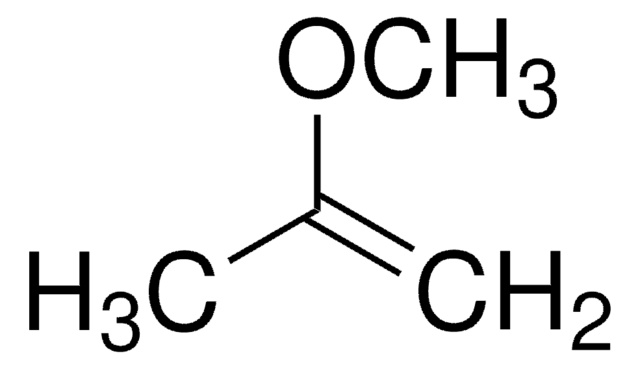B85919
2-Butanol
ReagentPlus®, ≥99%
Sinonimo/i:
sec-Butyl alcohol
About This Item
Prodotti consigliati
Densità del vapore
2.6 (vs air)
Livello qualitativo
Tensione di vapore
12.5 mmHg ( 20 °C)
Nome Commerciale
ReagentPlus®
Saggio
≥99%
Forma fisica
liquid
Temp. autoaccensione
761 °F
Limite di esplosione
9.8 %
IVD
for in vitro diagnostic use
Indice di rifrazione
n20/D 1.397 (lit.)
P. eboll.
98 °C (lit.)
Punto di fusione
−115 °C (lit.)
Densità
0.808 g/mL at 25 °C (lit.)
Stringa SMILE
CCC(C)O
InChI
1S/C4H10O/c1-3-4(2)5/h4-5H,3H2,1-2H3
BTANRVKWQNVYAZ-UHFFFAOYSA-N
Cerchi prodotti simili? Visita Guida al confronto tra prodotti
Descrizione generale
Applicazioni
- As a precursor to produce 2-butanone in presence of KMnO4 oxidant and CPC (N-cetylpyridinium chloride) micellar catalyst.
- In the production of CH3NH3PbI3 perovskite films.
Note legali
Avvertenze
Warning
Indicazioni di pericolo
Consigli di prudenza
Classi di pericolo
Eye Irrit. 2 - Flam. Liq. 3 - STOT SE 3
Organi bersaglio
Central nervous system, Respiratory system
Codice della classe di stoccaggio
3 - Flammable liquids
Classe di pericolosità dell'acqua (WGK)
WGK 1
Punto d’infiammabilità (°F)
80.6 °F - closed cup
Punto d’infiammabilità (°C)
27 °C - closed cup
Certificati d'analisi (COA)
Cerca il Certificati d'analisi (COA) digitando il numero di lotto/batch corrispondente. I numeri di lotto o di batch sono stampati sull'etichetta dei prodotti dopo la parola ‘Lotto’ o ‘Batch’.
Possiedi già questo prodotto?
I documenti relativi ai prodotti acquistati recentemente sono disponibili nell’Archivio dei documenti.
Il team dei nostri ricercatori vanta grande esperienza in tutte le aree della ricerca quali Life Science, scienza dei materiali, sintesi chimica, cromatografia, discipline analitiche, ecc..
Contatta l'Assistenza Tecnica.







